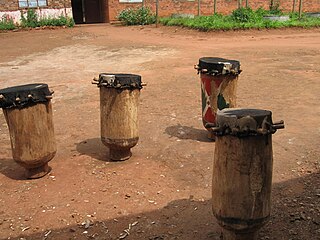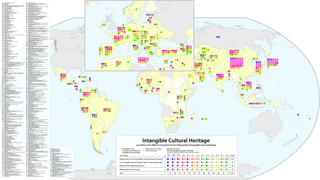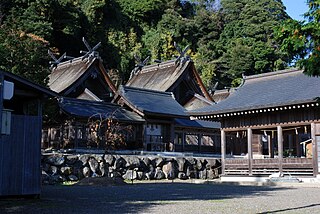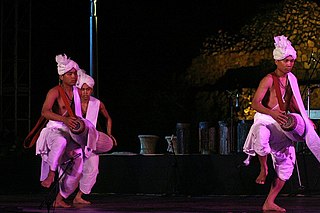Garifuna music is an ethnic music and dance with African, Arawak, and Kalinago elements, originating with the Afro-Indigenous Garifuna people from Central America and Saint Vincent and the Grenadines. In 2001, Garifuna music, dance, and language were collectively proclaimed as a Masterpiece of the Oral and Intangible Heritage of Humanity by UNESCO.
The Proclamation of Masterpieces of the Oral and Intangible Heritage of Humanity was made by the Director-General of UNESCO starting in 2001 to raise awareness of intangible cultural heritage and encourage local communities to protect them and the local people who sustain these forms of cultural expressions. Several manifestations of intangible heritage around the world were awarded the title of Masterpieces to recognize the value of the non-material component of culture, as well as entail the commitment of states to promote and safeguard the Masterpieces. Further proclamations occurred biennially. In 2008, the 90 previously proclaimed Masterpieces were incorporated into the new Representative List of the Intangible Cultural Heritage of Humanity as its first entries.

The karyenda is a traditional African drum. It was the main symbol of Burundi and its Mwami (King) and had semi-divine status. The Mwami was said to interpret the beatings of the karyenda into rules for the kingdom.

The culture of Burundi is based on local tradition and common influence with its neighbors.

The Anastenaria, is a traditional barefoot fire-walking ritual with ecstatic dance performed in some villages in Northern Greece and Southern Bulgaria. The communities which celebrate this ritual are descended from refugees who entered Greece from Eastern Thrace following the Balkan Wars of 1911–12 and the Population exchange between Greece and Turkey in 1923.

Nhã nhạc is a traditional music of Vietnam. Vietnamese court music is very diverse, but the term nhã nhạc refers specifically to the Vietnamese court music performed from the Trần dynasty of the 13th century to the Nguyễn dynasty at the end of the 20th century.

Balinese dance is an ancient dance tradition that is part of the religious and artistic expression among the Balinese people of Bali island, Indonesia. Balinese dance is dynamic, angular, and intensely expressive. Balinese dancers express the stories of dance-drama through bodily gestures including gestures of fingers, hands, head, and eyes.

Tourism in Burundi refers to tourism in Burundi. Bujumbura, the largest city and former capital of Burundi, is a major tourist attraction of the country. In addition to this, Lake Tanganyika is a popular tourist attraction.

Lhamo, or Ache Lhamo, is a classical secular theatre of Tibet with music and dance that has been performed for centuries, whose nearest western equivalent is opera. Performances have a narrative and simple dialogue interspersed with comedy and satire; characters wear colorful masks. The core stories of these theatrical plays are drawn mostly from ancient Indian Buddhist folk tales, lives of important people and historical events from Tibetan civilization. However the ceremonial, dance and ritual spectacles strongly reflects the Tibetan Royal Dynastic period.

UNESCO established its Lists of Intangible Cultural Heritage with the aim of ensuring better protection of important intangible cultural heritages worldwide and the awareness of their significance. This list is published by the Intergovernmental Committee for the Safeguarding of Intangible Cultural Heritage, the members of which are elected by State Parties meeting in a General Assembly. Through a compendium of the different oral and intangible treasures of humankind worldwide, the programme aims to draw attention to the importance of safeguarding intangible heritage, which UNESCO has identified as an essential component and as a repository of cultural diversity and of creative expression.

Sada Jinja (佐太神社) is a Shinto shrine in Matsue, Shimane Prefecture, Japan. The Taisha-zukuri north, central and south halls of 1807 are Important Cultural Properties.

Ramman is a religious festival and ritual theatre of the Garhwal region in India. It is a festival of the Garhwali People celebrated in many villages of the region. Although there are many Rammans, such as the Jak Ramman, one of the most popular is the masked Ramman of the Saloor Dungra village of the Painkhanda Valley in the Chamoli district in Uttarakhand, India.

The Festivity of La Mare de Déu de la Salut is a festival celebrated in Algemesí (Valencia), Spain, from August 29 to September 8. The festival is in honour of the patron saint of Algemesí, La Mare de Déu de la Salut, and has been dated back to 1247. The holiday was awarded the UNESCO "Masterpieces of the Oral and Intangible Heritage of Humanity" designation on November 28, 2011.

Huaconada is a ritual dance performed in the village of Mito in the province of Concepción in the central Peruvian Andes. It has been inscribed on the Representative List of the Intangible Cultural Heritage of Humanity by UNESCO in 2010.
The Drametse Ngacham is a sacred dance performed in the village of Drametse in eastern Bhutan. It is performed twice a year during the Drametse festival, which occurs on the fifth and tenth months of the Bhutanese calendar. The festival is organized by the Ogyen Tegchok Namdroel Choeling Monastery to honor Padmasambhava, an 8th-century Buddhist master.

Meitei Sankirtan, also known as Meitei Sankirtana or Manipuri Sankirtan or Manipuri Sankirtana, is a Meitei cultural form of performing art involving ritual singing, drumming and dancing performed in the temples and domestic spaces in Manipur in India. Through the performances which exhibit unparalleled religious devotion and energy, the performers narrate the many stories of Krishna often moving the spectators to tears. It is practiced primarily by the Meitei Hindus in Manipur and by the Vaishnava Manipuri population settled in the neighbouring States of Tripura and Assam. In December 2013, UNESCO inscribed "Sankirtana: Ritual singing, drumming and dancing of Manipur" in the Representative List of the Intangible Cultural Heritage of Humanity.

Sebiba is the term used in Algeria to designate a festival and the Tuareg people's dance performed on this occasion and accompanied by female drummers in the Sahara oasis of Djanet in the Tassili n'Ajjer region in southern Algeria. The dance originated among the descendants of black African slaves and is part of the celebrations for the Islamic Ashura Festival. The dance was recognized by UNESCO in 2014 for its significance to humanity's intangible cultural heritage.

The intangible cultural heritage (ICH) of Meitei civilization is recognised, honoured, preserved as well as promoted by the UNESCO, the Ministry of Culture of the Union Government of India, the Government of Armenia, the State Government of Manipur, the State Government of Assam, the State Government of Tripura, among many other notable institutions.





















